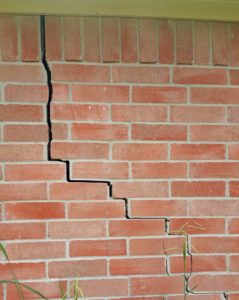
—
“Most of the home builders in Houston switched to post-tension cable foundations several decades ago because it was cheaper and quicker to install. This decision, along with the decision to build thinner concrete slabs, was driven by the home builders’ desire to boost profits. Unfortunately, the people who have purchased new homes in this time period are stuck with ‘minimally functional’ home foundations that fail at an alarming rate. And these home foundation failures are happening not only with greater frequency but at much earlier times after construction,” stated R.D. Campbell of Houston Foundation Repair.
Mr. Campbell’s experience and comments are consistent with the opinions of Houston area structural engineers. According to Mr. Campbell, “The post-tension cable system for concrete slab foundations that has and is replacing the standard steel rebar system has a fundamental flaw. The home builders’ theory is that they can achieve a minimum of 50 psi (pounds per square inch) compression throughout the slab and most importantly, at the middle of the slab, with the cables. The theory assumes the home builder will tighten the cables to a sufficient degree that the ‘squeezing’ will add the necessary strength and rigidity. The problem with this concept is that prior to the pouring of the concrete the home builder has dug trenches around the interior and exterior of the soon to be built home and these trenches will be filled with concrete. The trenches become the perimeter and interior concrete beams and they anchor the slab into the soil. So now the home builder is trying to ‘squeeze’ 40 or 60 or more feet of a flat concrete slab plus the attached concrete beams plus the soil between the concrete beams. The result is that the home builder simply cannot tighten the post-tension cables enough to give the concrete slab the strength to resist bending movements. The middle of the slab foundation is the weakest area and the surrounding areas are only a little stronger. I have seen this play out many times.”
Many Houston area structural engineers feel that the inherently weaker residential post-tensioned slab are at risk from two major factors. First, the non-uniform weight distribution of the house puts great stress on the slab foundation. Second, the non-uniform thickness of fill soil under the foundation can be a major contributing factor in damaged slab foundations. “In my experience, the earliest appearing and most severe damages have occurred in houses that have the heaviest loads (multi-story brick or stone veneer walls, typically in the front) located over the thickest fill soil area, which characteristically is farthest downslope on the lot (which is typically in the front),” states C. Randolph Riddell, a Houston area independent structural engineer with 41 years of experience.
When asked about the impact on homeowners who buy new homes in Houston Mr. Campbell is very sympathetic. He said homeowners are uninformed consumers. The home builders, architects, and structural engineers know post-tension cable foundations are inferior and the only way around these inferior foundations is to design your own house and specify a thicker and stronger foundation.
Mr. Campbell said that home foundations with steel rebar in the concrete slab would generally serve the homeowner 25 to 30 years before accumulated stresses from soil movement or other factors did any serious damage. Now he says that the time frame is 10 to 15 years and he claims it is the direct result of the inherently weaker post-tension cable system. He also added that after 10 years the home builder warranty has expired and home builders have no liability to fix anything.
“What we see in the future is more dramatic weather changes which will result in more dramatic soil movement. The droughts of 2011 and 2013 exposed some of the overall weaknesses of home foundations in Houston and caused many millions of dollars in damages. We are beginning to see severely damaged foundations and homes at the 5 and 6 year point, something we never saw before,” stated Mr. Campbell.
When asked about the cost to support and level these foundations for the long-term Mr. Campbell took a deep breath. He said small foundation repair jobs are priced at $5000 and bigger jobs, a two story 3500 square foot house for example, can easily be $60,000. It just doesn’t seem fair that something as “permanent” as a home’s concrete slab foundation will suffer damage so soon and cost so much to repair.
Company Name: Houston Foundation Repair
Contact Name: R.D. Campbell
City: Houston
State: Texas
Country: USA
Phone: 281-231-2701
Email: rd@foundationrepairhouston.com
Website URL: http://FoundationRepairHouston.com
Source URL: http://authoritynewsnetwork.com/homeowners-are-getting-crushed-by-flawed-post-tension-cable-foundations/
Release ID: 210640



 Google
Google RSS
RSS